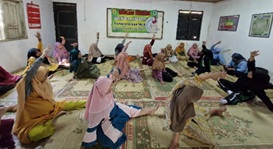Edukasi Kehamilan Risiko Tinggi melalui Media Permainan Ular Tangga di Kelas Ibu Hamil High-risk Pregnancy Education through Snakes and Ladders Game in Antenatal Class
Main Article Content
Abstract
One of the action plans for the acceleration of maternal mortality rate reduction is ensuring that every mother can access quality health services. Low maternal knowledge in recognizing obstetric and neonatal danger signs results in late decisions to get medical help. Maternity classes are to provide knowledge to pregnant women and their families. The learning method through the Snakes and Ladders game is expected to increase the active participation of pregnant women and communicate with other pregnant women. This activity was conducted on August 5, 2024, to 15 pregnant women in the Maternal Class in Masaran Village, Sragen Regency. The Snakes and Ladders game requires a banner as a game board, dice, and question cards. Pregnant women's knowledge about high-risk pregnancy was analyzed through pre and post-test questionnaires. Pregnant women looked enthusiastic during the game. Representatives of each group completed the game. Other members got involved by providing answers according to the questions their group got. Some pregnant women asked questions after the game was over. Wilcoxon pre and post-test of the Snakes and Ladders game obtained a value of ρ = 0.001. It is concluded that education through the Snakes and Ladders game is proven to improve pregnant women's knowledge about high-risk pregnancy.
Downloads
Article Details

This work is licensed under a Creative Commons Attribution-ShareAlike 4.0 International License.
Authors who publish with this journal agree to the following terms:
- Any article on the copyright is retained by the author(s).
- Author grant the journal, right of first publication with the work simultaneously licensed under a Creative Commons Attribution License that allows others to share work with acknowledgment of the work authors and initial publications in this journal.
- Authors are able to enter into a separate, additional contractual arrangements for non-exclusive distribution of published articles of work (eg, post-institutional repository) or publish it in a book, with acknowledgment of its initial publication in this journal.
- Authors are permitted and encouraged to post their work online (e.g., in institutional repositories or on their websites) prior to and during the submission process, as can lead to productive exchanges, as well as earlier and greater citation of published work.
- The article and any associated published material is distributed under the Creative Commons Attribution-ShareAlike 4.0 International License
References
Hardianti, R. N., & Prihatin, S. (2020). Pengaruh Media Permainan Ular Tangga terhadap Pengetahuan Siswi SMP 6 Ternate tentang Cara Mengatasi Nyeri Haid. Jurnal Kebidanan, 9(2), 130–135. https://doi.org/10.35890/jkdh.v9i2.158
Kaparang, M. J., Baharta, F., & Lisnawati. (2022). Pelaksanaan Metode Ular Tangga pada Kelas Ibu Hamil Terhadap Peningkatan Pengetahuan Ibu tentang Tanda Bahaya Kehamilan. Jurnal Bidan Cerdas, 4(1), 62–68. https://doi.org/10.33860/jbc.v4i1.763
Kemenkes RI. (2014). Pedoman Pelaksanaan Kelas Ibu Hamil (pp. 1–52). Kemenkes RI. https://eprints.triatmamulya.ac.id/1447/1/108. Pedoman Pelaksanaan Kelas Ibu Hamil.pdf
Kemenkes RI. (2023). Profil Kesehatan Indonesia 2022. Kemenkes RI.
Kurniawan, M. R. (2017). Analisis Karakter Media Pembelajaran Berdasarkan Gaya Belajar Peserta Didik. JINoP (Jurnal Inovasi Pembelajaran), 3(1), 491–506. https://doi.org/10.22219/jinop.v3i1.4319
Longgupa, L. W., Nurfatimah, & Siregar, N. Y. (2020). Pelaksanaan Permainan Ular Tangga dalam Kelas Ibu Hamil di Kecamatan Poso Pesisir Kabupaten Poso. Poltekita: Jurnal Pengabdian Masyarakat, 1(1), 23–28. https://doi.org/10.33860/pjpm.v1i1.73
Martilova, D., Hayati, S., Amran, H. F., Safitri, Y., Kirana, D. N., Ingelia, & Dale, D. S. (2023). Media Permainan Ular Tangga dan Puzzle Sebagai Upaya Peningkatan Pengetahuan Ibu Hamil dan Kader Tentang Kehamilan Sehat di Dusun V Kampung Baru Kualu. BERNAS: Jurnal Pengabdian Kepada Masyarakat, 4(3), 1751–1757. https://doi.org/10.31949/jb.v4i3.5145
Sabila, S., Nabila, K., Ayunda, S. S., & Khasanah, N. (2021). Pengaplikasian Game Edukasi (Ular Tangga) untuk Meningkatkan Konsentrasi terhadap Minat Belajar Peserta Didik. Prosiding SEMAI Seminar Nasional PGMI, 499–518. https://proceeding.uingusdur.ac.id/index.php/semai/article/view/439
Sadarang, R. A. I., Haerana, B. T., & Bujawati, E. (2023). Determinan Kehamilan Risiko Tinggi Wanita Usia Subur di Indonesia. Jurnal Ilmu Kesehatan Masyarakat, 12(05), 352–364. https://doi.org/10.33221/jikm.v12i05.2124
Sulistiyawati, I. (2021). Analisa Metode Simulasi Ular Tangga Terhadap Pengetahuan Dan Sikap Ibu Hamil Tentang Pencegahan Stunting. Jurnal Kebidanan Akademi Kebidanan Jember, 5(1), 28–35. https://doi.org/10.59837/jpmba.v2i9.1559
Wati, A. (2021). Pengembangan Media Permainan Ular Tangga untuk Meningkatkan Hasil Belajar Siswa Sekolah Dasar. Mahaguru: Jurnal Pendidikan Guru Sekolah Dasar, 2(1), 68–73. https://doi.org/10.33487/mgr.v2i1.1728
